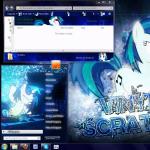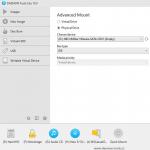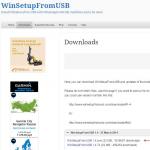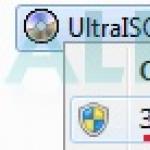Earlier in Opera, the sidebar was one of the killer features that made this browser so beloved by loyal users. Using the sidebar, you could get quick access to your bookmarks, downloads, mail or notes and work with them without closing the currently open page. It was really handy.
The sidebar of the new browser (opened with the Ctrl + Shift + S keyboard shortcut) largely repeats the functions of its predecessor, but they are implemented using special extensions. This gives us hope that the sidebar capabilities in Opera will increase over time as third-party developers create more and more extensions. Right now, you can view your Twitter feed, RSS feeds, manage installed extensions, add notes, and much more in the sidebar. Below you will find a description of several Opera sidebar extensions that you can install right now.
V7 Bookmarks
Viewing your favorites is one of the most convenient and logical functions that you can implement in the sidebar of your browser. Thanks to it, you can quickly add and delete new bookmarks, move them between folders and, of course, open your favorite sites.

TweetDeck Sidebar
If you are a fan of the Twitter service and cannot live without the latest news and a minute (or have to keep track of them due to the nature of your work), then the TweetDeck Sidebar extension will come to your rescue. It allows you to open your TweetDeck feed right in the sidebar and watch with one eye for updates to your feeds.
SimpleExtManager
This simple extension manager will allow you to enable or disable needed extensions on the fly, as well as provide quick access to their settings. In addition, you can create groups of extensions that can be activated all together with one click of the mouse. Thus, you can create several groups, one of which can be used, for example, for work, the other - for games or multimedia, and switch between them as needed.
V7 Notes
The trademark of the Opera browser in a new reincarnation. It is worth noting that V7 Notes looks and works no worse than the old note-taking and is just as capable of helping you out in the situation when you need to quickly save a quote, link or text from the currently open page.
Google keep sidebar
The Google Keep service is deservedly loved by users for its versatility and cross-platform functionality. With it, you can create quick notes, lists, reminders and voice recordings right in the Opera sidebar, and then view them on the Web or on your mobile device.

The history panel
This is a simple bookmark manager for the sidebar. All elements in it are sorted by time of visit and domains, there is a search bar. Clicking on the desired site will open it in a new browser tab.
InoReader Sidebar
InoReader is one of the best online rss readers. If you are a user of it, then install a special extension for the sidebar, which will allow you to view new articles without having to open the main web interface.
Opera's sidebar and related extensions are an interesting novelty that may well attract additional users to this browser. For example, I seriously thought about using Opera as my main browser. And you?
Organize gadgets.
There are several ways to organize widgets.
You can pin all widgets to the sidebar.
You can change the order in which widgets appear in the sidebar. To do this, drag the gadget to a different position.
You can pin some widgets to the sidebar and place others right on your desktop.
You can remove all gadgets from the sidebar and place them on your desktop. With this arrangement of gadgets, it might be worth closing the sidebar.
Placing a gadget on the desktop
Gadgets can be removed from the sidebar and placed on the desktop.
To remove a gadget from the sidebar, drag it to the desktop. To bring the gadget back, drag it to any part of the sidebar.
If you can't drag the gadget, you can try grabbing another part of it, such as an edge or corner.
Close the sidebar
The sidebar with the removed widgets can be closed.
Sidebar customization Windows.
You can hide the Windows Sidebar, show it in front of all windows, add and remove gadgets, detach them to place them on the desktop, and more.
 Side panel
Windows
Side panel
Windows
Side panel Windows : Questions and answers.
Here are answers to some common questions about the Windows Sidebar.
Hide all
What is Windows Sidebar?
Using the sidebar, you can set up quick access to the information you need without cluttering your workspace. The sidebar sits on the desktop and contains gadgets - customizable mini-programs that display constantly updated information and allow you to perform common tasks without opening windows. For example, you can view picture slideshows, constantly updated weather forecasts, and news headlines.
 Side panel
Windows
Side panel
Windows
How do I open the side panel?
The sidebar opens by default, but if you closed it, you can reopen it.
Opening the sidebar
Can I customize the sidebar?
Yes. You can decide which of the installed gadgets to place on the sidebar and which to remove. You can also add multiple instances of a specific gadget and detach one or more gadgets from the sidebar to fit onto your desktop. If you want the sidebar to remain visible while you work in an open window, you can configure it to always appear on top of all windows. You can also close the sidebar, leaving the disconnected gadgets visible on the desktop.
Individual gadgets can also be customized. For example, you can set the clock or select pictures to include in your slide show.
For more information, see Customize the Windows Sidebar.
Can I change the width of the sidebar?
No, the sidebar has a fixed width. However, you can detach gadgets from the sidebar and place them anywhere on your desktop.
Right-click the gadget you want to disconnect and choose Detach from side panel.
Drag the gadget to the desired location on the desktop.
Friends, enough time has passed since the release of the program iTunes 11 version, but to this day we receive letters from users who cannot figure out the new interface of this program. The text of the letter from the reader Elena:
Hello site, I can't apply the ones described on your site. The thing is, my iTunes program is missing the left menu bar. Tell me how to turn it on?
Especially for Elena and other users who have problems with the initial setup of iTunes 11, we decided to talk about the left side menu bar, which is available in version 11, just the developers decided to hide it by default. The left menu bar can be launched manually, which is what we will do today. Indeed, the sidebar is present in almost all of our instructions.
For how to work with iTunes 11 on first launch, we will.
Launching Sidebar in iTunes 11
There are several ways to launch the sidebar in iTunes. Below are all the launch methods for both Mac users and Wndows users:

Launch Sidebar for Windows Users:
- Keyboard shortcut: Ctrl + S
Launching Side Menu for Mac OS Users:
- Keyboard shortcut: Cmd + Alt + S
- Menu: View - Show Side Menu
Enabling the menu bar: File, Edit, View ..
For those wishing to include in iTunes and fix the menu bar File, Edit, View, Manage, Store, Help. Click View - Show Menu Bar.

You can also turn the menu on and off using the hotkeys:
- In iTunes for Windows - Ctrl + B
- In iTunes for Mac OS - Cmd + /
After enabling the sidebar, you can use iTunes 11 to download music, create ringtones, work with videos or photos, just as you did in previous versions of iTunes.
Opera browser consists of five groups of on-screen elements:
- Menu bar
- Tab bar
- Navigation buttons (Back, Forward, Refresh / Stop, Home)
- Combined address bar and search bar
- View area
The following items are available on the Mac Menu Bar:
| Menu | Available actions |
|---|---|
| Opera | View information about the version of the Opera browser, access settings, log into your Opera account, delete personal data, import browsing data, download wallpaper and extensions, exit the browser. |
| File | Manage tabs and windows, open files and locations, save pages to local disk, or print. |
| Edit | Working with text (copy, paste, highlight), search for text on pages, spell check. |
| View | Zoom, show or hide the bookmark bar or extensions sidebar, turn presentation mode on or off, view in full screen mode, access homepage items (Quick Bar & News), view downloads, manage extensions and themes, access the password manager and switch developer tools. |
| History | Go back and forth, re-display closed tabs and windows, go to recently viewed pages, view your entire history of work on the Internet. |
| Bookmarks | Display the bookmark manager, create a bookmark on the current page, go to pages added to the bookmark folders. |
| Developer | Developer tools, source viewer and task manager. |
| Window | Minimize the current window, zoom, or select open windows and tabs. |
| Help | Access Opera Help pages, view keyboard shortcuts, and the ability to report a problem. |
For Windows and Linux users, the main menu contains various tools for working with the browser. With it, you can open new tabs and windows, change the page scale, display Opera service pages: Express panel, news, bookmarks, downloads, history or settings.

The tab bar allows you to jump from one page to another while viewing multiple pages at the same time. Click on a page tab to view its contents. To open a new tab, click the button + on the tab bar.
Using the navigation buttons, you can go to the necessary browser pages:
| Button | Action |
|---|---|
| Back one page. | |
| Forward one page. | |
| Reload the current page. | |
| Open the start page. |
Using the combined address bar and search bar, you can navigate to sites and search the Internet. You can enter a website address such as http://www.opera.com/ or search keywords such as Opera browser. ...
The viewport displays the content of the page. This is where you interact with the page: read text, view images, follow links, etc.
Side panel
Opera's sidebar, accessible from the start page, provides quick access to messaging services, Speed Dials, bookmarks, personalized news, tabs, history, extensions, downloads and settings.
The sidebar can be docked and visible on every page in the browser, or you can hide it for convenience while browsing other pages. This can be done through Easy Setup.
Opera sidebar control
You can use the sidebar to personalize the pages displayed, messaging services, and features.
To customize the sidebar, hold down Ctrl, left-click (Mac) or right-click (Win / Lin) on the sidebar and check the boxes for the functions you want to display.
To access the sidebar settings, go to the menu Settings(Preferences on Mac)> Browser > Sidebar.
Tabs

Opera can organize multiple pages in a single window using tabs that resemble shortcuts to folders for papers. Tabs allow you to work on multiple pages at the same time without closing the page while you need it.
To open a new tab, click the button + on the tab bar.
Previewing the contents of a tab
To view the contents of a tab without leaving the current page, you can hover your mouse over the tab. Tab preview is especially useful if you have many pages open. You can enable tab preview in Opera preferences. To turn tab preview on or off, follow these steps:

- Go to Settings (Preferences on Mac).
- Click on Browser on the side panel.
- In chapter User interface check the box Show tab previews.
Closing tabs
To close a tab, hover over it and click x... To close all tabs except the current one, hold down Ctrl, left-click (Mac) or right-click (Win / Lin) on the current tab and select Close Other Tabs ... Alternatively, you can close all tabs to the right of the current tab by clicking Close Tabs to the Right.
If you closed a tab by accident, or want to open a recently closed tab, hold down Ctrl, left-click (Mac) or right-click (Win / Lin) on the tab and select Reopen Last Other Tabs.
Fixing tabs
Locking tabs allows Opera to prevent accidentally closing tabs or highlighting important pages. The locked tab cannot be closed. To pin or unpin a tab in the tab bar, hold down Ctrl, left-click (Mac) or right-click (Win / Lin) on the tab and select Pin tab/Unpin Tab ... The pinned tab moves to the left side of the tab bar, from where you can quickly open it.
Managing tabs
If you want an open tab to appear in a separate window, just drag the tab from the tab bar. Tabs can also be dragged between open windows.
If you want to open a copy of the page in a new tab, hold down Ctrl, left-click (Mac) or right-click (Win / Lin) on the tab and select Duplicate Tab .
All tabs open in a window can be saved as a Speed Dial folder. Hold Ctrl, left-click (Mac) or right-click (Win / Lin) in the tab bar and select Save Tabs as Speed Dial Folder ... A new untitled folder will appear at the bottom of the Speed Dial.
Opening closed tabs and viewing synced tabs through the tab menu

If you like to open many tabs at once, the tab menu will make it easier for you to organize, view, and open the ones you want.
The tab menu is on the right side of the tab bar. Click the tab menu to see a list of recently closed tabs and open tabs from all synced devices.
You can interact with the tab menu using the keyboard. Press Ctrl + M to open or close the tab menu. Press the arrow buttons to navigate the list of tabs. Press Enter to open a tab from the list.
To make using the tab menu even more convenient, it makes sense to enable tab preview.
Context menu
The context menu appears when you hold down Ctrl and left-click (Mac) or right-click (Win / Lin) on any element of the web page. The appearance of the menu depends on the type of element (page, text, link or picture).
Context menu pages appears when you hold down Ctrl and left-click (Mac) or right-click (Win / Lin) anywhere on the page where there are no links, pictures or text. This menu offers various navigation options (go back, go forward, or reload the page), as well as options for saving the page to the Speed Dial or bookmarks, viewing the page's source code, saving the page as PDF, etc.
Context menu links appears when you hold down Ctrl and left-click (Mac) or right-click (Win / Lin) a link, and allows you to choose how to open or save the corresponding page or address.
Context menu Images appears when you hold down Ctrl, left-click (Mac) or right-click (Win / Lin) any picture, and offers options for opening, copying or saving this picture.
If you hold down Ctrl and left-click (Mac) or right-click (Win / Lin) any image to which the link is linked, the menu that appears will contain menu items for both the image and the link.
Changing the scale
Opera's zoom feature makes small print easier to read. To zoom in on your Mac, select View > Zoom In/Zoom Out ... Windows or Linux users should go to menu O> Zoom... Thus, you set the scale only for the page you are currently on.
You can also use the keyboard shortcuts Ctrl or ⌘ + + / - to zoom in and out.
You can set the default zoom to ensure that all pages you view open at the desired zoom level. To set the default scale, follow these steps:
- Go to Settings (Preferences on Mac).
- Click on Basic on the side panel.
- In chapter Appearance you'll find Page zoom.
- Choose at what scale you would like to view the pages.
After setting the page scale, all pages you open will be displayed at the specified scale. If you had any tabs open, reload them to view the pages at the default zoom level just set.
If you want to revert to the original format, Mac users should click View> Actual Size. Windows and Linux users should go to menu O> Zoom and choose Reset zoom to the right of + .
Full screen mode and presentation mode
Opera allows you to view pages in full screen and presentation mode. In full screen mode, the menu bar is not visible, but the tab bar and combined address bar and search bar remain on the screen.
To turn full screen mode on or off, select View > Enter / Exit Full Screen ... Windows and Linux users can go to menu O> Page and choose Full screen.
In presentation mode, available for Mac users, all menus and toolbars are hidden and the page takes up the entire screen. This feature is especially useful for presentations.
To turn presentation mode on or off, select View > Enter / Exit Presentation Mode .
In any of these modes, Mac users can bring up the menu bar on the screen by hovering the mouse cursor over the top border of the screen.
Press Esc to exit full screen and presentation mode on any platform.
Search for text on a page
Opera can search for keywords in the text on a page. To find a word or phrase on a page, press Ctrl + F or ⌘ + F on your keyboard. Enter text in the search box.
During the search, the words found are highlighted in green. If a word occurs repeatedly on the page, the found words are highlighted in yellow and their number is indicated in the search field. Use the right or left arrow keys to move from one found word to another.
Uploading and managing files
When you download a file from the site, a download message appears on the right below the combined address and search bar. This message turns on the download progress bar and disappears when the download is complete.
This causes a new icon to appear to the right of the combined address bar and search bar. Click this icon to view a list of recently downloaded files or remove them from your download history.
Select View > Downloads on Mac. On Windows and Linux go to menu O> Downloads .
The location where downloaded files are saved by default can be changed in the settings. To do this, follow these steps:
- Go to Settings (Preferences on Mac).
- Click on Browser on the side panel.
- In chapter Downloads press the button Change ... .
- Select the folder where the downloaded files should be saved and click Select.
In addition, in this menu, you can configure the browser so that it always asks where to save the downloaded files.
This article provides answers to the most common questions about Windows sidebar.
What is Windows Sidebar?
Using the sidebar, you can set up quick access to the information you need, avoiding clutter in the workspace. The sidebar is located on and contains gadgets - customizable gadgets that show constantly updated information and allow you to perform many operations without opening. For example, you can show regularly updated weather forecasts, news headlines, and picture demonstrations.
Windows sidebar
How do I open the side panel? What gadgets are included with this version of Windows?
The gadgets that come with Windows include a calendar, clock, contacts, feed headers, slideshow, puzzle and notepad.
Can I install additional gadgets? How do gadgets work?
Any gadget can be added to the sidebar. A widget added to the dashboard can be used directly on it, or detached and placed on. If you close the sidebar, you can use the gadgets on your desktop.




